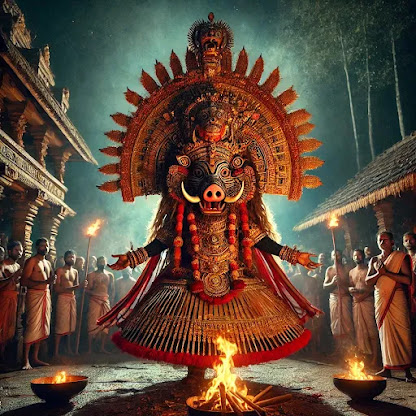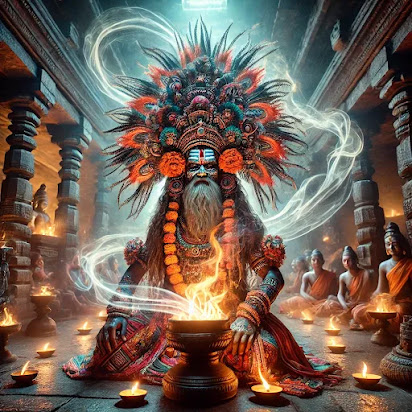Mysteries of Bhuta Kola, Panjurli Daiva, and Guliga Daiva – The Spiritual Stories Behind Kantara
Mysteries of Bhuta Kola, Panjurli Daiva, and Guliga Daiva – The Spiritual Stories Behind Kantara
Introduction
Bhuta Kola, an ancient ritualistic performance from Karnataka, is more than just an art—it is a divine invocation of spirits that bridges humans with the supernatural. Among the deities revered in this tradition, Panjurli Daiva and Guliga Daiva hold a significant place. Their origins, purpose, and spiritual relevance have deep roots in Hindu mythology, particularly in the Shaivite tradition. This article explores their celestial birth, their descent to Earth, and their role in cosmic balance, drawing from Puranas, Vedas, and other spiritual scriptures.
1. Bhuta Kola: The Sacred Dance of Spirits
Bhuta Kola, practiced predominantly in the Tulu-speaking regions of Karnataka and Kerala, is an ancient form of spirit worship that predates even the Vedic traditions. The word Bhuta means spirit, and Kola signifies ritual performance. Unlike traditional Hindu temple worship, Bhuta Kola follows animistic traditions that worship nature spirits and guardian deities.
1.1 Bhuta Worship in Ancient Texts
Rig Veda (Mandala 10, Hymn 85) refers to spirits of nature governing elements such as wind, water, and forests.
Skanda Purana (Shivamahatmya Kanda) mentions Shiva granting authority to Bhutas (spirits) to protect different regions of Earth.
Shiva Purana (Rudra Samhita, Chapter 21) states that Bhutas were created from Shiva’s energy to serve as protectors of dharma.
This indicates that Bhuta Kola is not just a folk tradition but has deep mythological and spiritual significance.
2. Panjurli Daiva: The Boar Spirit of Divine Protection
2.1 Origin of Panjurli Daiva
The story of Panjurli Daiva originates from Hindu legends, where he is often depicted as a divine spirit in the form of a wild boar (Varaha), closely associated with Lord Vishnu’s third incarnation, Varaha Avatara.
According to Tulu oral traditions, Panjurli was born from the tears of Goddess Parvati, when she saw the suffering of beings due to demonic influences.
Markandeya Purana (Chapter 12) mentions that divine spirits emerged from cosmic elements to protect regions from evil forces.
Panjurli, as per Shiva’s decree, was sent to Earth to guard sacred lands, forests, and people from destructive forces.
2.2 Role in Earthly Realms
Protects villagers, ensuring harmony between nature and humans.
Worshiped in Dakshina Kannada, Udupi, and Malnad regions as a guardian deity.
Bhuta Kola performances invoke Panjurli to maintain cosmic balance.
3. Guliga Daiva: The Fierce Protector of Dharma
3.1 The Birth of Guliga Daiva
Unlike Panjurli, Guliga Daiva has a more ferocious and uncompromising nature. According to legends:
Shiva Purana (Kotirudra Samhita, Chapter 27) describes Guliga as born from Lord Shiva’s sweat during his Rudra Tandava dance.
Shiva, enraged by Adharma (unrighteousness), created a fierce force to maintain divine justice.
Guliga was sent to Earth with the task of punishing those who violate cosmic laws.
3.2 Role in Earthly Realms
Known as the wrathful spirit of justice, ensuring truth and righteousness.
Worshiped in coastal Karnataka and Kerala, where devotees seek divine intervention for justice.
His blessings are sought in disputes, conflicts, and injustices, as he is considered an impartial divine judge.
4. Connection to Lord Shiva
Lord Shiva’s role as the Supreme Divine Force is deeply intertwined with Bhuta Kola and the deities associated with it.
4.1 Shiva’s Role in Bhuta Worship
Shiva, as Bhuteshwara (Lord of Spirits), is the ultimate source of Bhuta Kola.
Shiva Purana (Rudra Samhita, Chapter 14) states that Shiva appointed celestial spirits as Earth’s protectors.
Shiva’s companions—the Bhutas and Ganas—are seen as divine manifestations of the same spirits invoked in Bhuta Kola.
4.2 Influence of Shaivism on Panjurli and Guliga
Panjurli’s divine protection mirrors Shiva’s role as Pashupati (Lord of Beings).
Guliga’s ferocity is akin to Shiva’s Rudra aspect, who destroys evil to uphold dharma.
In Shakti cult traditions, both deities are considered extensions of Shiva’s cosmic energy.
5. Historical Evidence and Cultural Relevance
5.1 Archaeological and Textual References
Mundkur Temples (Karnataka, 8th Century CE) have ancient carvings depicting Bhuta spirits.
Udupi Manuscripts (12th Century CE) record rituals related to Bhuta Kola traditions.
Tulu inscriptions from the Vijayanagara era (14th Century CE) mention Panjurli and Guliga worship.
5.2 Scientific Perspective
Anthropologists believe Bhuta Kola is an ancient tribal tradition that merged with Hinduism.
Psychologists suggest spirit possession in Bhuta Kola has healing effects on the community.
Genetic research on coastal tribes shows ancestral links to early Dravidian rituals.
6. Bhuta Kola, Spiritual Awakening, and the Modern World
In today’s fast-paced world, Bhuta Kola serves as a reminder of our connection to nature and divinity.
Bhagavad Gita (Chapter 18, Verse 61) states that the Supreme Lord resides in all beings, guiding their destiny.
Shiva Sutras (1.2) mentions that liberation comes by realizing the unity between man and the divine.
Bhuta Kola embodies this spiritual realization, allowing devotees to experience divine consciousness through rituals.
The traditions of Bhuta Kola, Panjurli Daiva, and Guliga Daiva are more than folklore; they represent a spiritual and mythological reality deeply intertwined with Hinduism and Lord Shiva. Their origins, connected to divine energies, continue to guide communities, emphasizing protection, justice, and cosmic harmony.
Understanding these traditions through Puranic scriptures, historical findings, and spiritual interpretations offers a profound insight into their significance in today’s world. As the mystical dance of Bhuta Kola continues to captivate believers and scholars alike, it remains a powerful testament to the living tradition of Hindu spirituality.
The universe is whispering its secrets—are you ready to listen?
Dare to know more? Enter the realm of cosmic truth.
At the end of this journey, you will never see reality the same way again. Are you ready to break the illusion? Deep dive into www.rudradoota.com








0 Comments:
Post a Comment
Subscribe to Post Comments [Atom]
<< Home